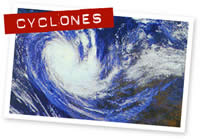Difference between Cyclone and Tornado
Key Difference: Cyclones are considered as oceanic phenomena, while tornadoes can occur over land as well as water. A cyclone is generally defined in meteorology as an area of closed, circular fluid motion rotating in the same direction as the Earth. A tornado is a violent rotating column of air that is contact with both the ground as well as a cumulonimbus cloud.
To many people cyclones and tornadoes are the same thing. However, this is not true. Cyclones and tornadoes are different in many ways. In order to fully understand the differences, let’s look at the definition for each of these disasters.
 A cyclone is generally defined in meteorology as an area of closed, circular fluid motion rotating in the same direction as the Earth. It has a high pressure outside and a low pressure inside. The center of the cyclone is usually known as an eye and has the lowest atmospheric pressure. A tropical cyclone (one that occurs in tropical areas) usually feeds on the heat that is released when moist air rises, resulting in condensation of water vapor.
A cyclone is generally defined in meteorology as an area of closed, circular fluid motion rotating in the same direction as the Earth. It has a high pressure outside and a low pressure inside. The center of the cyclone is usually known as an eye and has the lowest atmospheric pressure. A tropical cyclone (one that occurs in tropical areas) usually feeds on the heat that is released when moist air rises, resulting in condensation of water vapor.
Depending on the size and intensity of the cyclone, wind speed can range anywhere from 32mph to 157mph. Different types of cyclones include extratropical, subtropical, and tropical; cyclones can transition between these phases given the right conditions. Cyclones are considered to be as oceanic phenomena, as they can die out on lands due to loss of moisture, but they still manage to cause destruction due to wind and rain. A cyclone has a diameter on the scale of hundreds of kilometers and is comprised of several to dozens of convective storms. Cyclones can be determined using Pulse-Doppler radars and their strength can be determined using scales such as the Beaufort scale and Saffir-Simpson scale, though scales may differ according to countries.
 A tornado is a violent rotating column of air that is contact with both the ground as well as a cumulonimbus cloud. It is also known as twisters or cyclones. The base of a tornado that touches the earth is usually surrounded by a cloud of dust and debris. A tornado depending on its size can have wind speeds between 40mph and 360mph. Tornadoes often develop from a class of thunderstorms known as supercells. Supercells contain mesocyclones, an area of organized rotation a few miles up in the atmosphere, usually 2–10 km across. As the mesocyclone lowers to the base of the cloud, it begins to start taking in cool air from the downdraft region of the storm. The warm air in the updraft and the cool air in the downdraft form a wall of rotating air, forming the beginnings of a tornado. A tornado dies or dissipates when the downdraft encases the tornado and cuts off the warm air supply to the core, causing the vortex to weaken and eventually die.
A tornado is a violent rotating column of air that is contact with both the ground as well as a cumulonimbus cloud. It is also known as twisters or cyclones. The base of a tornado that touches the earth is usually surrounded by a cloud of dust and debris. A tornado depending on its size can have wind speeds between 40mph and 360mph. Tornadoes often develop from a class of thunderstorms known as supercells. Supercells contain mesocyclones, an area of organized rotation a few miles up in the atmosphere, usually 2–10 km across. As the mesocyclone lowers to the base of the cloud, it begins to start taking in cool air from the downdraft region of the storm. The warm air in the updraft and the cool air in the downdraft form a wall of rotating air, forming the beginnings of a tornado. A tornado dies or dissipates when the downdraft encases the tornado and cuts off the warm air supply to the core, causing the vortex to weaken and eventually die.
There are three different types of tornadoes: landspout, waterspout and multiple vortex. Landspout tornadoes are those that occur on land, while waterspout tornadoes occur on water. A multiple vortex tornado contains multiple vortices spinning inside the main vortex. Tornadoes can also be detected using Pulse-Doppler radars and their strength is determined using either the Enhanced Fujita Scale or the TORRO scale.
|
|
Cyclone |
Tornado |
|
Definition |
A Cyclone is an area of closed, circular fluid motion rotating in the same direction as the Earth. Most circulations are centered on areas of low atmospheric pressure. Mostly take place on water |
A tornado is a violent rotating column of air that is contact with the ground and a cumulonimbus cloud |
|
Composition |
Air, water, moisture |
Water droplets, dust, debris |
|
Shape |
Closed, circular fluid motion. The center is known as an eye |
Cylindrical columns/pillars, wedges |
|
Types |
Extratropical cyclones, Subtropical cyclones and Tropical cyclones |
Landspout, multiple vortex tornado, and waterspout |
|
Speed |
Tropical Cyclones can range anywhere from 32 mph to 157 mph |
Anywhere between 40mph and 360mph |
|
Rotation |
Clockwise in the Southern Hemisphere; counter-clockwise in the Northern Hemisphere |
Clockwise in the Southern Hemisphere; counter-clockwise in the Northern Hemisphere |
|
Scale for Measurement |
Beaufort Scale and Saffir-Simpson scale and may vary in different countries |
Fujita (F), Enhanced Fujita (EF), and TORRO (T) Scale |
|
Size |
Has a diameter on the scale of hundreds of kilometers |
Has a diameter on the scale of hundreds of meters |
|
How are they formed |
Comprised of several to dozens of convective storms |
Produced from a single convective storm (i.e. a thunderstorm or cumulonimbus cloud) |
|
Required Condition |
Require very low values of tropospheric vertical shear in order to form and grow, and generated in regions of near zero horizontal temperature gradient |
Requires substantial vertical shear of the horizontal winds to provide ideal conditions for tornado genesis, and usually happens in regions of large temperature gradient |
|
Life |
Days |
Minutes or hours |
Image Courtesy: ema.gov.au, airmail.net









Add new comment